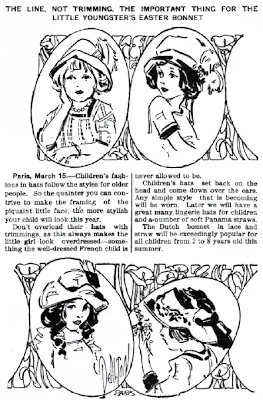 |
| Children's Easter Bonnet Fashions from Paris in 1913. |
Modern Easter bonnets for children are usually white wide-brimmed
hats with a pastel colored satin ribbon around it and tied in a bow. It
may also have flowers or other springtime motifs on top, and may match a
special dress picked out for the occasion.
Children in the United States often craft Easter bonnets for plays, parades and parties during spring festivities.
The following articles are from the Washington Herald's Woman's Section, April 16, 1911.
Smart Hats For Easter
by Marjorie
Will the Easter hat be a small, chic affair or a large shape with sinuously curled brim? I queried a buyer for a large department store the other day.
"Only a courageous prophet would hazard a guess," he cautiously replied. "We must wait until the fateful day and see what the majority of womankind are wearing to know definitely which way the millinery weathervane is pointing. And even then, directly as one shape has obtained too well, the more exclusive of our patrons drop it and designers turn their attention to creating something distinctive."
All of which makes the choice of an Easter hat as much of a riddle as the charming wearer herself. On can only give broad suggestions as to shape, colors and garnitures, for every woman must be her own best judge and choose a hat because it suits her face and style individually.
"The Time, the Place and the Woman" should be her slogan.
Hat Shapes Are Legion.
Brims roll, turn, twist and flare at all sorts of angles, meeting the requirements of so many faces. Crowns are both tall and broad. As a rule, the smaller the hat the larger the crown. Although the large shapes for dress wear have crowns which harmonize with the general contour, very tall crowns resembling inverted flower pots are shown on hats with scarcely any brim, except to one side the roll may be small or high.
The new envelope hat is very largely represented.
The sides turn back abruptly extending several inches higher then the crown. As a rule the hat rests across the face, having the flare front and back. It is also poised so as to have the point come coquettishly to one side. Another edition of the envelope hat has the tall flare only on the left side. This shape is very becoming to women who can carry chic style becomingly.
La Petite Chapeau.
The helmet hat is another style that is distinctively in the foreground of smart shapes, but it is admittedly very trying. There is a strong tendency to prevent this odd little shape from becoming "common," for the prices have remained high. The same quality straws used for cheaper hats are used for the helmet, but one pays for the shape, not the straw.
For example, in a rough straw quite the same grade as employed for a $1.25 was $4.50. The trimming is so placed to reveal the shape, again to conceal it.
 |
| These San Francisco "ladies" (cough) were photographed in their Easter hats, 1899. |
High bandeaus of natural ostrich feathers are laid around with a single lovely plume rising to considerable height in front, at the side or in back. A charming poke in Neapolitan straw was trimmed in this manner with ceil blue ostrich. At the base of the tall feather, standing erect like a sentinel, was a tightly folded rose in two shades of dull pink crepe de chine.
Then there are lovely close-fitting little tonques, turbans and pinched-up shapes of pliable straw, very Frenchy and chic-looking, with big, dashing bows of corded silk ribbon placed on the side or near the back, rising to a conspicuous height. A lovely one was shown in a rough coral straw with self-matching bengaline ribbon.
I note with pleasure that many of the unusual natives of Nature's garden appear on a number of the best hats. Very smart are the many dainty, fairy-like posies, including Japanese primrose, lilies-of-the-valley, Ageratum, violets, white, yellow, English daises, mignonette, forget-me-nots, primroses and honeysuckle. These complete the smaller and more dainty varieties, blended with feathery ferns and mosses.
Flowers are massed flat, again carelessly grouped, unconventionally falling in uneven lengths over the crown. Another becoming arrangement is to cluster flowers with tall steps to one side. Lilacs, carnations, roses, tiger lilies, orchids, popies, daisies, buttercups, dwarf sunflower, columbines and pansies are very effective for this purpose. The more usual in outline and coloring the more lavish the praise. Many of the small shapes are massed tightly with flowers and foliage. Crowns are mostly treated in this manner on the large hats, and the leaves laid down flat against the brim, slightly overlapping each other.
 |
| Poor Old World. "How she does long for the new Easter bonnet." Minneapolis Journal, 1905 |
Clusters of little roses and berries in bright hues are novel and very dainty features. Fine grasses dyed in fashionable hues appear with flowers in harmonious contrast.
The three shapes on this page have been copied from the latest models made up for smart spring wear. (upper, left)
The center model is a dress hat of black erin in a picture shape with helmet crown massed in white and black malines. The crin brim is faced with black satin. Three chiffon and satin roses are effectively arranged in the malines. The satin serves as a lining for the chiffon.
Model to the left, an envelope in blue milan, massed with aigrettes.
Model to the right, a French shape in satin finished coral straw with new wide flare. Panache of aigrettes, self-toned, rising from the center under and cabochon of corals and cut steel beads.


No comments:
Post a Comment
Thanks for your thoughts. All comments are moderated. Spam is not published. Have a good day!